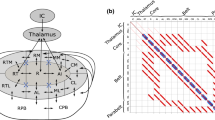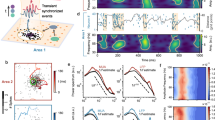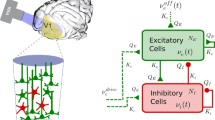Abstract.
A lumped continuum model for electrocortical activity was used to simulate several established experimental findings of synchronous oscillation which have not all been previously embodied in a single explanatory model. Moving-bar visual stimuli of different extension, stimuli moving in different directions, the impact of non-specific cortical activation upon synchronous oscillation, and the frequency content of EEG associated with synchrony were considered. The magnitude of zero lag synchrony was primarily accounted for by the properties of the eigenmodes of the travelling local field potential superposition waves generated by inputs to the cortex, largely independent of the oscillation properties and associated spectral content. Approximation of the differences in cross-correlation observed with differently moving bar stimuli, and of the impact of cortical activation, required added assumptions on (a) spatial coherence of afferent volleys arising from parts of a single stimulus object and (b) the presence of low-amplitude diffuse field noise, with enhancement of cortical signal/noise ratio with respect to the spatially coherent inputs, at higher levels of cortical activation. Synchrony appears to be a ubiquitous property of cortex-like delay networks. Precision in the modelling of synchronous oscillation findings will require detailed description of input pathways, cortical connectivity, cortical stability, and aspects of cortical/subcortical interactions.
Similar content being viewed by others
Author information
Authors and Affiliations
Additional information
Received: 22 December 1998 / Accepted in revised form: 16 March 2000
Rights and permissions
About this article
Cite this article
Wright, J., Bourke, P. & Chapman, C. Synchronous oscillation in the cerebral cortex and object coherence: simulation of basic electrophysiological findings. Biol Cybern 83, 341–353 (2000). https://doi.org/10.1007/s004220000155
Issue Date:
DOI: https://doi.org/10.1007/s004220000155




